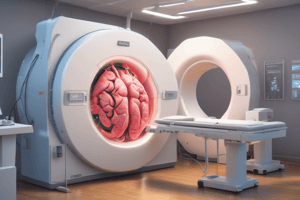Podcast
Questions and Answers
What is the primary difference between Axial Scanning and Helical Scanning in CT imaging?
What is the primary difference between Axial Scanning and Helical Scanning in CT imaging?
- Scan efficiency
- Exposure time
- Table movement (correct)
- Slice thickness
In Computed Tomography (CT) scanning, what type of projection is used for Scouts?
In Computed Tomography (CT) scanning, what type of projection is used for Scouts?
- PA projection
- Supine projection
- Lateral projection
- AP projection (correct)
How is the 'Pitch' defined in the context of CT scanning?
How is the 'Pitch' defined in the context of CT scanning?
- Overlap during scanning (correct)
- Slice thickness
- Distance between slices
- Table speed
Which factor affects the patient dose in CT scanning when increased?
Which factor affects the patient dose in CT scanning when increased?
What is the main advantage of Computed Tomography (CT) over traditional x-rays?
What is the main advantage of Computed Tomography (CT) over traditional x-rays?
How does Computed Tomography (CT) handle the issue of superimposition of structures?
How does Computed Tomography (CT) handle the issue of superimposition of structures?
Why is it important to have a 3rd dimension in medical imaging, as discussed in the text?
Why is it important to have a 3rd dimension in medical imaging, as discussed in the text?
What makes Computed Tomography (CT) able to distinguish between adjacent like objects with very little difference in contrast?
What makes Computed Tomography (CT) able to distinguish between adjacent like objects with very little difference in contrast?
What is used to represent a tiny block of tissue in a CT image?
What is used to represent a tiny block of tissue in a CT image?
Which tissues typically have a low Hounsfield Unit (HU) number?
Which tissues typically have a low Hounsfield Unit (HU) number?
How is the level of grey in a CT image determined?
How is the level of grey in a CT image determined?
What happens to the dose in a CT image if the mAs is reduced to maintain a constant noise level?
What happens to the dose in a CT image if the mAs is reduced to maintain a constant noise level?
What is the purpose of acquiring a scout in CT image production?
What is the purpose of acquiring a scout in CT image production?
How does the Scan Field of View (SFOV) impact CT image production?
How does the Scan Field of View (SFOV) impact CT image production?
What is the role of computer processing in CT image production?
What is the role of computer processing in CT image production?
Why is it important for Radiation Therapists to consider the Scan Field of View (SFOV) during CT Simulation?
Why is it important for Radiation Therapists to consider the Scan Field of View (SFOV) during CT Simulation?
Flashcards are hidden until you start studying
Study Notes
Differences in CT Scanning
- Axial scanning captures images in discrete slices, while helical scanning acquires continuous data as the patient moves through the scanner, allowing for faster imaging.
- Helical scanning results in overlapping images, enhancing the reconstruction process and creating more detailed three-dimensional datasets.
Projection Used for Scouts
- Scouts utilize a standard radiographic projection, typically a two-dimensional, panoramic view of the area being examined, serving as a preliminary check before full scans.
Definition of Pitch
- 'Pitch' in CT is defined as the ratio of table feed per rotation to the total width of the collimated x-ray beam, influencing image quality and exposure time.
Factors Affecting Patient Dose
- Increasing mAs (milliampere-seconds) directly raises the patient dose in CT scanning, as it governs the amount of radiation used for image acquisition.
Advantage of CT Over Traditional X-rays
- CT provides cross-sectional images, allowing for detailed visualization of complex structures and differentiation between adjacent tissues, which standard x-rays cannot achieve.
Handling Superimposition of Structures
- CT imaging utilizes computer algorithms to reconstruct images in multiple planes, effectively removing superimposition and revealing hidden anatomical details.
Importance of 3D in Medical Imaging
- Having a third dimension in imaging enables precise localization and relationship understanding among anatomical structures, enhancing diagnostic accuracy.
Distinguishing Adjacent Objects
- CT employs advanced spatial resolution and contrast distinction, supported by high-quality detectors and algorithms, allowing differentiation of similar-density tissues.
Representation of Tissue in CT Images
- A voxel is used to represent a tiny block of tissue in a CT image, indicating volume in three dimensions for accurate assessment.
Tissues with Low Hounsfield Unit (HU)
- Fat and air typically exhibit low HU numbers, indicating lower density compared to other tissues, useful for identifying abnormalities and characterizing lesions.
Determination of Grey Level in CT Images
- The grey level in a CT image corresponds to the Hounsfield Units, providing visual representation of tissue density based on specific attenuation values.
Effect of Reducing mAs
- Reducing mAs to maintain constant noise level will lead to an increase in the dose needed to ensure adequate image quality, potentially compromising patient safety.
Purpose of Acquiring a Scout
- Scouts are crucial for localization and planning, offering a quick reference to the anatomy for correct positioning and optimizing the subsequent scanning process.
Impact of Scan Field of View (SFOV)
- SFOV affects the area imaged and the detail captured; proper selection ensures relevant anatomy is included, enhancing the diagnostic capability of scans.
Role of Computer Processing in CT Images
- Computer processing is vital for reconstructing raw data into usable images, applying algorithms that enhance contrast and detail for better clinical interpretation.
Considerations for Radiation Therapists Regarding SFOV
- Radiation Therapists must consider SFOV during CT simulations to ensure accurate treatment planning and to minimize unnecessary radiation exposure to surrounding tissues.
Studying That Suits You
Use AI to generate personalized quizzes and flashcards to suit your learning preferences.




